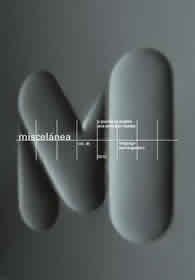Unificación de la semántica del infinitivo en inglés
DOI:
https://doi.org/10.26754/ojs_misc/mj.20129255Palabras clave:
infinitivo, gerundio, mundos posiblesResumen
Este artículo tiene dos objetivos. El primero es unificar las diversas interpretaciones del infinitivo en inglés. Adoptando el concepto de mundos posibles de Lewis (1986), sostendré que el infinitivo representa la incorporación de un mundo posible por el mundo "real". El segundo objetivo es explicar cómo ciertos predicados han llegado a seleccionar el infinitivo, el gerundio o ambos. Argumentaré que los cambios históricos junto con la restricción semántica del infinitivo pueden explicar el estado actual de la complementación.
Descargas
Citas
Bladon, R.A.W. 1968. “Selecting the to- or –ing nominal after like, love, hate, dislike and prefer”. English Studies 49: 203-214.
Bolinger, Dwight. 1968. “Entailment and the meaning of structures”. Glossa 2(2): 119-127.
—. 1984. “Surprise”. In L. J. Raphael, C. B. Raphael, and M. R. Valdovinos (eds.) Language and cognition: Essays in honour of Arthur J. Bronstein. New York/London: Plenum Press: 45-58.
Close, Reginald Arthur. 1962. English as a foreign language. London: George Allen & Unwin.
De Smet, Hendrik. 2004. “Semantics and variation in complement constructions: Gerunds and infinitives following the verb like”. Belgian Journal of English Language and Literature. New Series 2: 247-260.
Dirven, René. 1989. “A cognitive perspective on complementation”. In Jaspers, D., W. Klooster, Y. Putseys, and P. Seuren (eds.) Sentential Complementation and the Lexicon. Dordrecht: Foris: 113-139.
Dixon, Robert M. W. 1984. “The semantic basis of syntactic properties”. Berkeley Linguistics Society 10: 583-595.
Duffley, Patrick J. 1992. The English infinitive. London: Longman.
—. 2000 “Gerund versus infinitive as complement of transitive verbs in English”. Journal of English Linguistics 28(3): 221-248.
Duffley, Patrick J. 2003. “The gerund and the to-infinitive as Subject”. Journal of English Linguistics 31(4): 324-352.
—. 2006. The English gerund-participle: A comparison with the infinitive. New York: Peter Lang Publishing.
Fanego, Teresa. 1996a. “The development of gerunds as objects of subject-control verbs in English (1400-1760)”. Diachronica 13: 29-62.
—. 1996b. “On the historical development of English retrospective verbs”. Neuphilologische Mitteilungen 97: 71-79
—. 2004. “Is Cognitive Grammar a Usage-Based Model? Towards a Realistic Account of English Sentential Complements”. Journal of English and American Studies 29: 23-58.
Fauconnier, Gilles. 1994. Mental spaces: Aspects of meaning construction in natural language. Cambridge, MA: MIT Press, 1985. Reprint, Cambridge: Cambridge University Press.
Hirtle, Walter H. 1975. Time, aspect and the verb. Québec: Presses de l’Université Laval.
Jespersen, Otto. 1940. Modern English grammar on historical principles. Part V. London: George Allen & Unwin.
Kempson, Ruth M. and Randolph Quirk. 1971. “Controlled activation of latent contrast”. Language 47: 548-572.
Kiparsky, Paul and Carol Kiparsky. 1970. “Fact”. In Bierwisch, M. and K.E. Heidolph (eds.) Progress in linguistics. The Hague: Mouton: 143-173.
Lewis, David. 1986. On the Plurality of Worlds, Oxford: Basil Blackwell.
Mair, Christian. 2003. “Gerundial complements after begin and start: Grammatical and sociolinguistic factors, and how they work against each other”. In Rohdenburg, G. and B. Mondorf (eds.) Determinants of Grammatical Variation in English. Berlin and New York: Mouton de Gruyter: 329-345.
Morita, Hisashi. 2011. “To-futeisi-no imi-ni tuite (About the meaning of to-infinitive)”. Mulberry 60: 33-50.
Quirk, Randolph, Sidney Greenbaum, Geoffrey Leech and Jan Svartvik. 1985. A comprehensive grammar of the English language. London: Longman.
Rudanko, Juhani. 1988. Change and Continuity in the English Language. Studies on Complementation over the Past Three Hundred Years. Lanham, New York and Oxford: University Press of America.
—. 1989. Complementation and Case Grammar: A Syntactic and Semantic Study of Selected Patterns of Complementation in Present-Day English. Albany: State University of New York Press.
Smith, Michael B. and Joyce Escobedo. 2001. “The semantics of to-infinitival vs. –ing verb complement constructions in English”. Chicago Linguistic Society 37: 549-563.
Stowell, Tim. 1982. “The tense of infinitives”. Linguistic Inquiry 13: 561-570.
Verspoor, Marjolijn. 1996. “The story of -ing: A subjective perspective”. In Pütz, M. and R Dirven (eds.) The Construal of Space in Language and Thought. Berlin and New York: Mouton de Gruyter: 417-454.
—. 1999. “To infinitives”. In L. Stadler and C. Eyrich (eds.). Issues in Cognitive Linguistics 12. Berlin: Mouton de Gruyter: 505-526.
Wierzbicka, Anna. 1988. The semantics of grammar. Amsterdam: John Benjamins.
Wood, Frederick T. 1956. “Gerund versus Infinitive”. English Language Teaching 11: 11-16.
Descargas
Publicado
Cómo citar
Número
Sección
Licencia
Derechos de autor 2013 Hisashi Morita

Esta obra está bajo una licencia internacional Creative Commons Atribución-NoComercial 4.0.


